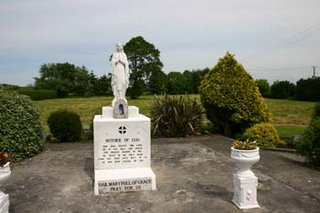
I visited two graveyards. The first was called John Paul II. It’s fairly new. The graves are personally tended by the families and are full of mementos and memorabilia.

One of the Irish women I've met grew up in the Gaeltacht (the region of Ireland where Irish is the first language. Note: Gaelic is the root of the language, but that’s spoken in many places. The proper term for the language here is Irish). I asked her why weren’t more people into speaking Irish. She said Ireland has had a mixed history in regards to patriotic things. For most of this century, those who were super patriotic were also likely to be IRA members or sympathizers. As a result people have been hesitant to fly their flag or speak Irish for fear of others making assumptions. That’s been changing in the last few years, but it’s slow. Apparently this town and county were a big support/sending base to the north during the Troubles. To this day there’s a farm up the road with four military vehicles parked next to the barn.
At the graveyard, I saw this stone carved all in Irish. Based on what she’d said, I wondered about the man’s life and history. There were two guys tending a grave on the far side of the cemetery. Despite my reputation for boldness, I decided to let discretion be the better part of valor and not ask.

Just down the road was the Famine Graveyard.

I didn't realize there would be no headstones. So many people died during the famine (in the 1800’s?) that they were just buried in a mass grave. Now there is a path that walks a triangle around a tiny chapel. Mary stands between the chapel entrance and the field where the dead were laid. No headstones. No record of names. Just an area surrounded by a strip of mown grass and a path for remembering. The area between the statue and the tree behind her is the graveyard. It looks bigger in the picture than it was in person.


2 comments:
You are brave to drive there. I would totally need those signs to remember which side to drive on!
Cemeteries tell stories. Ireland has such a rich and sad history.
Wow, I feel like I am getting a guided tour through Ireland.
Post a Comment